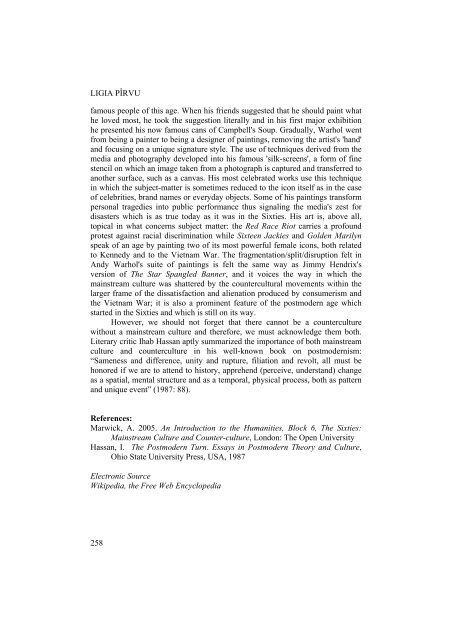culture, subculture and counterculture - Facultatea de Litere
culture, subculture and counterculture - Facultatea de Litere
culture, subculture and counterculture - Facultatea de Litere
Create successful ePaper yourself
Turn your PDF publications into a flip-book with our unique Google optimized e-Paper software.
LIGIA PÎRVU<br />
famous people of this age. When his friends suggested that he should paint what<br />
he loved most, he took the suggestion literally <strong>and</strong> in his first major exhibition<br />
he presented his now famous cans of Campbell's Soup. Gradually, Warhol went<br />
from being a painter to being a <strong>de</strong>signer of paintings, removing the artist's 'h<strong>and</strong>'<br />
<strong>and</strong> focusing on a unique signature style. The use of techniques <strong>de</strong>rived from the<br />
media <strong>and</strong> photography <strong>de</strong>veloped into his famous 'silk-screens', a form of fine<br />
stencil on which an image taken from a photograph is captured <strong>and</strong> transferred to<br />
another surface, such as a canvas. His most celebrated works use this technique<br />
in which the subject-matter is sometimes reduced to the icon itself as in the case<br />
of celebrities, br<strong>and</strong> names or everyday objects. Some of his paintings transform<br />
personal tragedies into public performance thus signaling the media's zest for<br />
disasters which is as true today as it was in the Sixties. His art is, above all,<br />
topical in what concerns subject matter: the Red Race Riot carries a profound<br />
protest against racial discrimination while Sixteen Jackies <strong>and</strong> Gol<strong>de</strong>n Marilyn<br />
speak of an age by painting two of its most powerful female icons, both related<br />
to Kennedy <strong>and</strong> to the Vietnam War. The fragmentation/split/disruption felt in<br />
Andy Warhol's suite of paintings is felt the same way as Jimmy Hendrix's<br />
version of The Star Spangled Banner, <strong>and</strong> it voices the way in which the<br />
mainstream <strong>culture</strong> was shattered by the countercultural movements within the<br />
larger frame of the dissatisfaction <strong>and</strong> alienation produced by consumerism <strong>and</strong><br />
the Vietnam War; it is also a prominent feature of the postmo<strong>de</strong>rn age which<br />
started in the Sixties <strong>and</strong> which is still on its way.<br />
However, we should not forget that there cannot be a counter<strong>culture</strong><br />
without a mainstream <strong>culture</strong> <strong>and</strong> therefore, we must acknowledge them both.<br />
Literary critic Ihab Hassan aptly summarized the importance of both mainstream<br />
<strong>culture</strong> <strong>and</strong> counter<strong>culture</strong> in his well-known book on postmo<strong>de</strong>rnism:<br />
“Sameness <strong>and</strong> difference, unity <strong>and</strong> rupture, filiation <strong>and</strong> revolt, all must be<br />
honored if we are to attend to history, apprehend (perceive, un<strong>de</strong>rst<strong>and</strong>) change<br />
as a spatial, mental structure <strong>and</strong> as a temporal, physical process, both as pattern<br />
<strong>and</strong> unique event” (1987: 88).<br />
References:<br />
Marwick, A. 2005. An Introduction to the Humanities, Block 6, The Sixties:<br />
Mainstream Culture <strong>and</strong> Counter-<strong>culture</strong>, London: The Open University<br />
Hassan, I. The Postmo<strong>de</strong>rn Turn. Essays in Postmo<strong>de</strong>rn Theory <strong>and</strong> Culture,<br />
Ohio State University Press, USA, 1987<br />
Electronic Source<br />
Wikipedia, the Free Web Encyclopedia<br />
258












